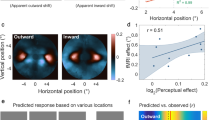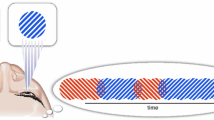Abstract
WHEN the two eyes view dissimilar images, we experience binocular rivalry, in which one eye's view dominates for several seconds and is then replaced by that of the other eye1,2. What causes these perceptual changes in the absence of any change in the stimulus? We showed previously that some neurons in monkey cortical area MT show changes in activity during motion rivalry that reflect the perceived direction of motion3. To determine whether perception-related modulation of activity occurs in other visual cortical areas, we recorded from individual neurons in VI, V2 and V4 while monkeys reported the perceived orientation of rival gratings of two orthogonal orientations. Many cells, particularly in V4, showed patterns of activity that correlated with the perceptual dominance and suppression of one stimulus. The majority were orientation-selective and could be driven equally well from either eye. It has been previously suggested that binocular rivalry involves reciprocal inhibition between monocular neurons within VI (for example, see ref. 4), but our results do not support this view; rather, we propose that binocular rivalry arises through interactions between binocular neurons at several levels in the visual pathways, and that similar mechanisms may underlie other multistable perceptual states that occur when viewing ambiguous images.
Similar content being viewed by others
References
Helmholtz, H. V. Physiological Optics, translated for Opt. Soc. Am. (1924) from Handbuch der Physiologischen Optik 3rd edn (Voss, Hamburg, 1909) (Dover, New York, 1962).
Breese, B. Psychol. Rev. 3, 1–65 (1899).
Logothetis, N. & Schall, J. Science 245, 761–763 (1989).
Blake, R. Psychol. Rev. 96, 145–167 (1989).
Levelt, W. On Binocular Rivalry (Royal VanGorcum, Assen, 1965).
Blake, R. & Rox, R. Nature 249, 488–490 (1974).
Campbell, F. & Howell, E. J. Physiol., Lond. 225, 19P–21P (1972).
Whittle, P., Bloor, D. & Pocock, S. Percept. Psychophys. 4, 183–188 (1968).
Borselino, A., De Marco, A., Allazetta, A., Rinesi, S. & Bartolini, B. Kybernetik 10, 139–144 (1972).
Fox, R. & Herrmann, J. Percept. Psychophys. 2, 432–436 (1967).
Walker, P. Percept. Psychophys. 18, 467–473 (1975).
Logothetis, N., Pauls, J. & Poggio, T. Curr. Biol. 5, 552–563 (1995).
Author information
Authors and Affiliations
Rights and permissions
About this article
Cite this article
Leopold, D., Logothetis, N. Activity changes in early visual cortex reflect monkeys' percepts during binocular rivalry. Nature 379, 549–553 (1996). https://doi.org/10.1038/379549a0
Received:
Accepted:
Issue Date:
DOI: https://doi.org/10.1038/379549a0
- Springer Nature Limited
This article is cited by
-
Fish self-awareness: limits of current knowledge and theoretical expectations
Animal Cognition (2022)
-
Gestalts at threshold could reveal Gestalts as predictions
Scientific Reports (2021)
-
A continuum of invariant sensory and behavioral-context perceptual coding in secondary somatosensory cortex
Nature Communications (2021)
-
Dynamical mechanisms of a monolayer binocular rivalry model with fixed and time-dependent stimuli
Nonlinear Dynamics (2021)
-
Mind–Body Connection and Causation: Conceptual and Experimental Advances
Foundations of Science (2021)





